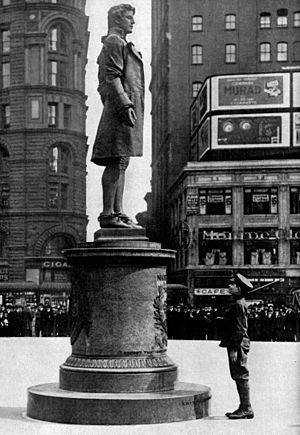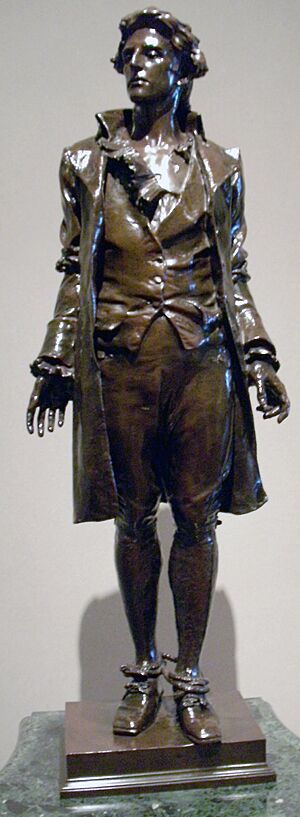Nathan Hale (statue) facts for kids
Quick facts for kids Nathan Hale |
|
|---|---|
 |
|
| Artist | Frederick William MacMonnies |
| Year | 1893 |
| Type | Sculpture |
| Medium | Bronze |
| Subject | Nathan Hale |
| Location | City Hall Park, New York City |
The Nathan Hale sculpture is a famous artwork. It was first shown on November 25, 1893. This date is known as Evacuation Day (New York). The sculpture was put up by the Sons of the Revolution in New York.
It first stood at the corner of Broadway and Chambers Street (Manhattan) in Manhattan. Today, you can find it near the steps of City Hall. The sculpture shows Nathan Hale looking out at people. This spot is very close to where he was executed on September 22, 1776. This happened during the American Revolution. The sculpture is eight feet tall. It was made by Frederick William MacMonnies. He was a student of Augustus Saint-Gaudens. The sculpture cost about $15,000 when it was finished and put in place.
Creating the Sculpture
The Nathan Hale statue was made in Paris, France. It arrived in the United States about two weeks before it was supposed to be shown. This was planned for June 8, 1893. The statue was displayed in August Saint-Gaudens' studio. This studio was at 148 West 36th Street.
A special base, called a pedestal, was made for it. Architect Stanford White designed this pedestal. The pedestal was also eight feet tall. The statue was placed facing the meeting point of Broadway and Chambers Street. This location was chosen because it was near where Nathan Hale was executed.
What the Sculpture Shows
In the sculpture, Nathan Hale looks like he is facing his executioners. He appears to be saying his famous words. These words are, My only regret is that I have but one life to give for my country. Hale's arms are tied in the sculpture. He wears a coat and a vest. His shirt is open, and his neck is bare. This shows he is ready for his execution.
His feet are also tied. Nathan Hale was six feet tall in real life. In the sculpture, his hands are held out as far as the ropes allow. A person named Henry Marquand said this statue was the best one made in the United States.
Other Places to See It

You can find copies of this famous statue in several places. The Metropolitan Museum of Art has one. There are also copies at the Art Museum at Princeton University. You can see another at the National Gallery of Art. The Art Institute of Chicago also has a copy. Even the White House has one. Finally, the Mead Art Museum at Amherst College has a version too.

